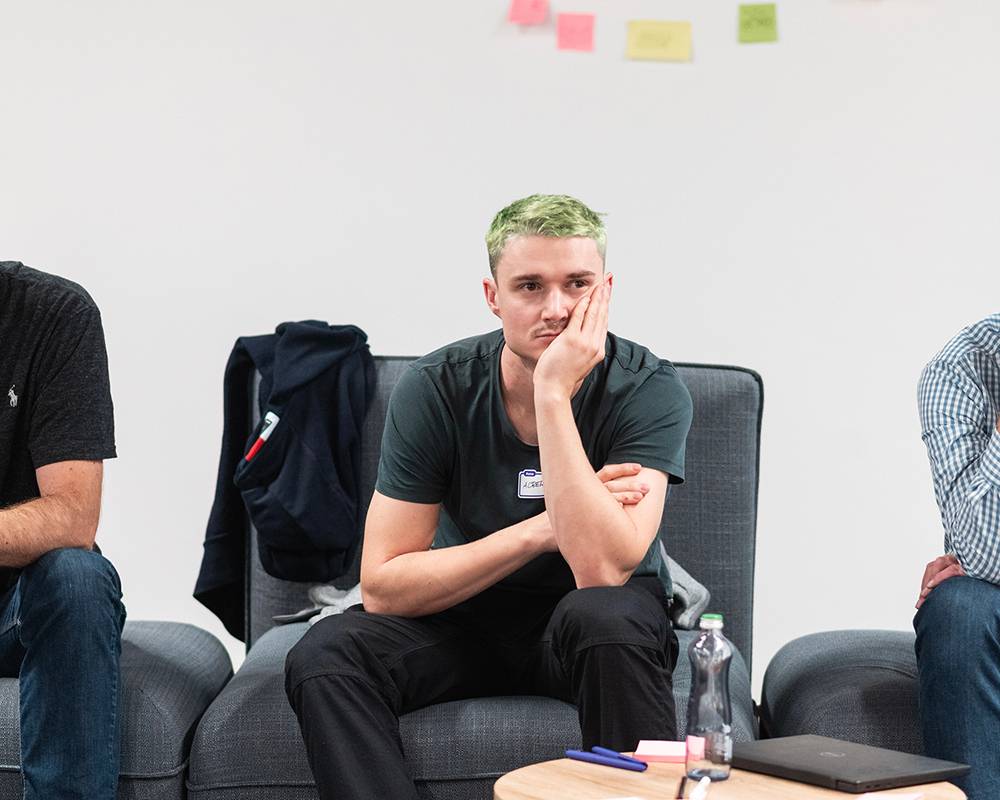A self-taught designer that learned everything by trial and error prior to his Hyper Island journey, Albert Zikmund now manages multiple teams as VP of Product Experience at Ataccama. In this blog, the MA Digital Experience Design alumnus provides a superb account of leadership, environment, tools and user-centred design as a product designer. Welcome to the first in a series of blogs exploring our Masters’ courses alumni journeys.
Albert’s journey post-Hyper Island graduation began with being accepted onto an internship at frog design in Munich as an interaction designer, working on digital products for major car brands. A last-minute offer saw Albert join the startup, Veracity Protocol in New York, where he applied his trade as a product designer for just over two years. The next move was to Ataccama. It was here that Albert really started climbing the ladder through the ranks. First, he led a team of five designers, but a quick progression now sees him leading four other teams – all related to product design.
Creating a productive product experience environment
Ataccama is a Czech-Canadian company developing and selling enterprise software (B2B) that enables big companies to organise, and manage their data. In other words, users of the Ataccama platform can make sure their data are valid, complete, consistent, up to date and thus reliable.
format_quote“I’m leading teams of product designers, UX researchers, UX writers, technical writers (documentation) and a design system team,” says Albert. “The duties of all these people overlap quite a bit. We’re responsible for ‘doing the things right’ and making sure our platform is usable and accessible to all of our users.
The mission for Albert and his teams is to deliver the best possible value for their users by researching what to build and ensuring it’s built well.
format_quote“Clearly, everyone on the Product Experience team needs to have a good understanding of what our users are dealing with and their intentions when it comes to data management and quality, so that we can shape the product accordingly.”
Albert’s job revolves mostly around operations as well as setting quality standards and controlling the quality of what is produced. “We’re striving to ensure teams are equipped with the tools and environment to do great work, and therefore avoid any obstacles,” he says.
But what creates a good and productive environment?
format_quote“Being with the team as much as possible and discussing the work as much as possible,” according to Albert. “Organising social events, going for drinks, changing the environment through off-sites and hackathons. We must make sure all designers have the tools and support they need – from good hardware to well-organised sync meetings or a clearly defined career ladder,” he continues.
That said, the real tools Albert talks about may not be what you quite expect.
format_quote“The most valuable tools product designers can get are empathy, communication, cooperation, and analytical thinking.”

Albert deep in thought or thinking about food?
For Albert, it’s not just the craft of design that the designers need to focus on. “Designers need to juggle a lot besides the design craft itself,” he explains. “A quality product delivers value to a user, and not only solves their problem, but it solves it well.”
Product designers must create usable and accessible product parts, which originate in seamless end-to-end flows, addressing the users’ needs. Designers at Ataccama have the luxury of leveraging tools from their own design system as well as a defined set of design principles. As for software tools, Figma is the go-to tool for designing the product from the ground up. You’ll also find some valuable resources in the Hyper Island Toolbox. But enough about us, let’s discover more about getting that all-important understanding of the users and how to be a good leader.
Gaining a good understanding of users
It’s crucial for a product designer to get as close as possible to the users. “This is objectively harder in the B2B world as the people buying the product (the decision makers) are usually not using it. So there’s a certain barrier between the actual users and the designers. We’re finding ways around this barrier,” says Albert.
Albert relies on a team of consultants who are in close contact with the users to gain in-depth knowledge about their needs. This is a tremendous help to designers as it provides them with initial feedback on new features we’re designing.
A dedicated UX Research team is also at Albert’s disposal as enablers of user understanding. As the main partner of product teams – particularly product designers – “they build and take care of our user community who provide us with regular feedback and engage in our user research activities,” he explains. Last but certainly not least, Albert and his teams utilise product analytics to get a complete picture of how users interact with their platform.
Leading by example
At Hyper Island, we are firm advocates of teamwork. For Albert, it’s teamwork that generates the inspiration to navigate a successful product design and development. As VP of Product Experience, he takes a much more supportive approach, diminishing any trace of hierarchy. “What’s helping me for sure is that all the people in the teams are exceptional, so they’re really partners in what we do, hands down. My job is to just make sure they have what they need to get the job done,” he says.
format_quote“I mostly chip in with my idea about the direction in which I believe we should go. I show how things can be even better, help to choose priorities, and cheer for the team. As much as management is part of the job, I’m trying to focus on leadership – and lead by example.”
Who is drawn to Hyper Island’s Masters’ courses?
Albert identifies two key groups of people that are likely to participate in Hyper Island’s Masters’ course:
The first being “people who have absolutely no idea what to do next in their life. They use the course to find a direction, meet new people, and see from new perspectives,” he says.
The second being the complete opposite! “People who have a clear idea about what to do next in their life. They use the course to deepen their existing knowledge, meet new people and see from new perspectives.”
That said, it all makes sense when Albert explains further. “The point is not that one group is better than the other. I’ve seen people from the first group transition to the second and vice versa (even multiple times over the course’s duration).”
To round off, Albert gives us a truly thoughtful reflection into his developmental expectations prior to beginning his journey at Hyper Island: “I like to think that I applied to Hyper having a perfect idea about what I wanted to do and how Hyper would help me get there (group #2). I’d been a self-taught designer and wanted to get a ‘formal education’ in the field. Through this experience I wanted to make sense of what I’d learned myself, understand what I’m good at and what I need to pay more attention to (the blind spots), gain confidence, and see where I can grow as a professional. I eventually learned much more than that. It’s fair to say Hyper had a significant impact on my career in a very positive way.”
Thank you, Albert.


